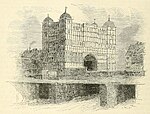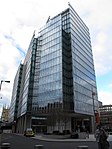St Olave's Church, Southwark
Buildings and structures demolished in 1926Churches dedicated to Saint Olav in LondonDemolished buildings and structures in LondonDestroyed churches in LondonFormer Church of England church buildings ... and 2 more
Former buildings and structures in the London Borough of SouthwarkFormer churches in the London Borough of Southwark

St Olave's Church, Southwark was a church in Southwark, England which is believed to be mentioned in the Domesday Book of 1086. It was located on Tooley Street which is named after the church, i.e. 't'olous'. It became redundant in 1926 and was demolished. It is now the location of St Olaf House, which houses part of the London Bridge Hospital.
Excerpt from the Wikipedia article St Olave's Church, Southwark (License: CC BY-SA 3.0, Authors, Images).St Olave's Church, Southwark
Tooley Street, London Borough (London Borough of Southwark)
Geographical coordinates (GPS) Address Nearby Places Show on map
Geographical coordinates (GPS)
| Latitude | Longitude |
|---|---|
| N 51.5065 ° | E -0.0865 ° |
Address
Tooley Street
SE1 2PR London, Borough (London Borough of Southwark)
England, United Kingdom
Open on Google Maps











